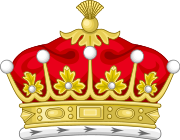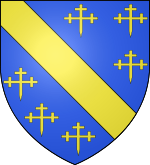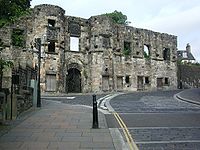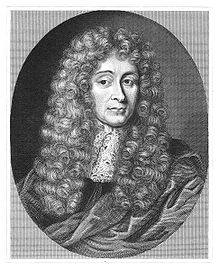- Earl of Mar
-
Earldom of Mar


The Arms of the Realm and Ancient Local Principalities of Scotland [1]The Mormaer or Earl of Mar is a title that has been created seven times, all in the Peerage of Scotland. The first creation of the earldom was originally the provincial ruler of the province of Mar in north-eastern Scotland. First attested in the year 1014,[2] the "family seat" eventually became Kildrummy Castle, although other sites like Doune of Invernochty were initially just as important.
The title evolved into a peerage title, and was made particularly famous by John Erskine, 23rd Earl of Mar who was an important Jacobite military leader during the 1715 Jacobite rising.
Owing to a nineteenth-century dispute, there are currently two Earls of Mar, however the Earldom of Kellie shared the title of Mar due to a mistake and misunderstanding between the rights to the title, James Thorne Erskine, 15th Earl of Mar and 17th Earl of Kellie and Margaret Alison of Mar, 31st Countess of Mar. The Earl of Mar and Kellie is the hereditary Clan Chief of Clan Erskine;[3] the Countess of Mar is the hereditary Clan Chief of Clan Mar.The Earldom of Mar is thought to be the oldest peerage in Great Britain, and even Europe.[4][5]
Early mormaers or earls
The first Mormaer of Mar is usually regarded as Ruadrí (fl. 1131), mentioned in the Book of Deer. Some modern sources give earlier mormaers, i.e. Muirchertach (Latinized as Martachus) and Gartnait (sometimes Gratnach), mentioned respectively in charters of the reigns of king Máel Coluim III (relating to the Céli Dé establishment of Loch Leven) and king Alexander I (relating to the monastic establishment of Scone), though in these cases certain identification with a particular province is difficult. The accounts of the Battle of Clontarf in some of the Irish annals name "Domnall son of Eimen son of Cainnech", Mormaer of Mar in Alba", as among those killed alongside Brian Boru.
The principal seats of the Mormaerdom were Migvie and Doune of Invernochty. The Mormaerdom seems initially to have rotated between two kin-groups, that represented by Morggán, and that represented by Gille Críst. The Mormaerdom was split upon the accession of Donnchadh, a descendant of Morggán. Donnchadh got the title of Mormaer and the wealthier and militarily more useful upland parts of Mar, and Thomas Durward, a descendant of Gille Críst through the female line, got the coastal, low-lying arable land. The line of Mormaers ended when Mormaer Thomas died childless in 1374.
15th century
While the eleventh (by some counts) holder of the title, Isabel Douglas, Countess of Mar, was alone at the Kildrummy Castle, Alexander Stewart entered it and forced her to sign a charter on August 12, 1404 yielding the earldom to him and his heirs. She revoked the charter later that year, but on marrying him, she gave him the earldom for life with remainder to her heirs. The King confirmed her last action the next year.
In 1426, Stewart resigned the title so that he could be granted a new one by the King, the new title being more "legitimate". The King did so, but specified that the earldom and associated lands would revert to the Crown upon the death of the Earl. In 1435, the Earl died, and Robert, Lord Erskine claimed the title, but the King claimed its lands under the specifications of reversion made in the patent. The issue remained unresolved until 1457, when James II obtained a court order declaring the lands as crown possessions. Thereafter, he bestowed the title on his son John, who died without heirs in 1479. It was next granted to James' other son, Alexander, Duke of Albany, but the title was then declared forfeit because of Alexander's alliances with the English. James III created his son John Earl of Mar in 1486, upon whose death in 1503 the title became extinct again.
16th–18th centuries
Mars Wark: The Earl of Mar's house in Stirling, situated on the approach to Stirling Castle, the Earl of Mar was governor of the castle during the mid-16th century.
The title was once again created in 1562, for James, Earl of Moray, son of James V, but he, too, could not produce a qualified heir. Moray rebelled in 1565 (see Chaseabout Raid) in protest at the marriage of Mary, Queen of Scots, and Henry Stuart, Lord Darnley. Consequently, Queen Mary made (or restored) the earldom of Mar for John, Lord Erskine, heir to the Lord Erskine, heir of the ancient Earls through a cousin of Isabel, who quarreled with James II about the Earldom. John, the sixth Earl counting from 1565, was attainted for rebellion in 1716 (he was also created Duke of Mar in the Jacobite peerage), and the Earldom remained forfeit for over a century.
19th century
In 1824, the Earldom was finally restored by Act of Parliament (5 Geo. IV c. 59) to John Francis Erskine, the heir of the attained Earl. His grandson, the ninth Earl, successfully claimed inheritance the earldom of Kellie and associated titles in 1835.
At the death of the ninth Earl of Mar and eleventh Earl of Kellie in 1866, the Earldom of Kellie and the family's estates passed to Walter Erskine, the cousin of the late Earl, and his heir male. Meanwhile, it was assumed that the Earldom of Mar passed to John Francis Goodeve, the late Earl's nephew, and his heir general. Goodeve changed his name to Goodeve Erskine; his claim was agreed upon by all. He even participated in the election of representative peers for the Peerage of Scotland. However, the Earl of Kellie submitted a petition to the House of Lords asking that the Earldom of Mar be declared his, dying before it could be considered. His son, the thirteenth Earl of Kellie, renewed the petition, and the Lords referred it to their Committee on Privileges. The petition made a number of claims:
- The original Earldom of Mar was a territorial title rather than a title of peerage and was therefore "indivisible." (In other words, the territory could not be separated from the title.)
- Alexander Stewart obtained a new Royal charter for the Earldom, rather than receiving it in right of his wife Isabel.
- After the death of Alexander Stewart, his lands were passed to the Sovereign in accordance with the charter, and thereafter were disposed of by the Crown.
- As the territorial Earldom was "indivisible", upon the termination of the territory, the earldom must have ended also.
- Therefore, since the territorial Earldom had already become non-existent, the 1565 grant was not a revival of that title. Rather, it was a totally new creation, this time in the form of a peerage title.
- Since the instrument of the 1565 grant cannot be found, the presumption ought to be that the Earldom passes to heirs-male, and not to heirs-general. Thus, the Earl of Kellie is entitled to the Earldom of Mar as he is the late Earl of Mar's heir male, while John Goodeve Erskine was an heir-general.
Goodeve Erskine had different ideas, however. He portrayed the Crown's takeover of the territorial Earldom not as pursuant to a charter, but rather as an act of tyranny. He argued:
- James I, in a tyrannical act, seized the lands of Alexander Stewart, when these should have passed to Robert, Lord Erskine.
- The "true" Earls never agreed to terminate their claim to the Earldom.
- The 1565 grant was a restitution of the old territorial Earldom rather than a new creation.
- Because the title is a restoration of a territorial Earldom, and because the territorial Earldom could pass to heirs-general, John Goodeve Erskine was the rightful heir, being the late Earl of Mar's heir-general.
The House of Lords Committee on Privileges ruled in 1875, to the dissatisfaction of many, that the Earldom of Mar was newly created in 1565, passed only to heirs-male, and therefore belonged to the Earl of Kellie, and not to Goodeve Erskine. The Lord Chancellor, Roundell Palmer, 1st Baron Selborne, declared it to be "final, right or wrong, and not to be questioned".
However, there was a sentiment that the Lords had decided wrongly. A bill was brought to Parliament, to allow Goodeve Erskine to assume the title, and was passed without dissent. The Earldom of Mar Restitution Act 1885 (48 & 49 Vict.) declared that because of the doubts relating to the 1565 creation, it would be assumed that there are two Earldoms of Mar. The Earldom created in 1565 would be held by the Earl of Kellie. The ancient Earldom, however, was declared to be still in existence, and was given to John Goodeve Erskine. For the purposes of precedence, it is assumed that the Earldom held by Goodeve Erskine's heirs was created in 1404.
Mormaers of Mar / early Earls
- Cainnech (?)
- Eimen (?)
- Domnall (d. 1014 (Clontarf))
- —
- Muirchertach (?) (fl. 1115)
- Ruadrí, Earl of Mar (fl. 1130s)
- Gille Chlerig, Earl of Mar (fl. 1140s)
- Morggán, Earl of Mar (d. before 1183)
- Gille Críst, Earl of Mar (d. c. 1203)
- Donnchadh, Earl of Mar (d. c. 1244)
- Uilleam, Earl of Mar (d. c. 1276)
- Domhnall I, Earl of Mar (d. c. 1301)
- Gartnait, Earl of Mar (d. c. 1305)
- Domhnall II, Earl of Mar (d. 1332)
- Thomas, Earl of Mar (d. 1374)
- Margaret, Countess of Mar (d. c. 1391)
- William Douglas, 1st Earl of Douglas and Mar suo jure uxoris Earl of Mar (1327–1384)
- James Douglas, 2nd Earl of Douglas and Mar (1358-k.1388 Battle of Otterburn)
- Isabel Douglas, Countess of Mar (c. 1360–1408)
Earls of Mar, first creation
Eardom of Mar Creation date c.1114 Created by King Malcolm II Peerage Peerage of Scotland First holder Ruadrí, Earl of Mar Present holder Margaret of Mar,
31st Countess of MarHeir apparent Susan of Mar, Mistress of Mar Remainder to heirs general of the body of the grantee Subsidiary titles Lord Garioch (1320) - Current subsidiary title: Lord Garioch (created 1320)
- John Francis Hamilton Sinclair Cunliffe Brooks Forbes Goodeve-Erskine, 28th Earl of Mar (1868–1932)
- Lionel Walter Erskine-Young, 29th Earl of Mar (1891–1965)
- James Clifton of Mar, 30th Earl of Mar (1914–1975)
- Margaret Alison of Mar, 31st Countess of Mar (born 1940)[6]
The heir presumptive is Susan Helen of Mar, Mistress of Mar (b. 1963). In the line of succession to the Earldom of Mar, she is followed by her eldest daughter, Isabel Alice of Mar (b. 1991).
Earls of Mar, second creation (1426)
- Alexander Stewart, 1st Earl of Mar (d. 1435)
Earls of Mar and Garioch, third creation (1459)
- John Stewart, 1st Earl of Mar and Garioch (d. 1479)
- Lands granted to James III's favorite, Robert Cochrane, in 1480 (d. 1482).
Earls of Mar and Garioch, fourth creation (1483)
- Alexander Stewart, 1st Duke of Albany (c. 1454–1485) (forfeit 1483)
Earls of Mar and Garioch, fifth creation (1486)
Earls of Mar, sixth creation (1562)
- James Stewart, Earl of Moray and Mar (d. 1570)
Earls of Mar, seventh creation (1565) (as so deemed by the House of Lords in 1875)
Earldom of Mar Creation date 1565 Created by Mary, Queen of Scots Peerage Peerage of Scotland First holder John Erskine,
18th Earl of MarPresent holder James Erskine,
14th Earl of MarHeir apparent Hon. David Erskine Remainder to heirs male of the body of the grantee Subsidiary titles Earl of Kellie, Viscount of Fentoun, Lord Erskine, Lord Erskine of Dirleton - John Erskine, 6th Lord Erskine, de jure later de facto 17th Earl of Mar, de jure 1st Earl of Mar (died 1572) (restored to Earldom of Mar, later deemed also to have been created Earl of Mar)
- John Erskine, 18th Earl of Mar, de jure 2nd Earl of Mar (c. 1558–1634)
- Walter John Francis Erskine, 12th Earl of Mar and 14th Earl of Kellie (1865–1955)
- John Francis Ashley Erskine, Lord Erskine (1895–1953)
- John Francis Hervey Erskine, 13th Earl of Mar and 15th Earl of Kellie (1921–1993)
- James Thorne Erskine, 14th Earl of Mar and 16th Earl of Kellie (b. 1949)
The heir presumptive is the present holder's brother, the Honourable Alexander David Erskine (b. 1952)
In popular culture
The Earl of Mar's Daughter is a ballad documented by Francis James Child.[7]
The Genesis song "Eleventh Earl of Mar" on their album Wind & Wuthering (1977) depicts the failure of the unsuccessful Jacobite campaign and the innocence of the Earl's young son.[8]
Mar is one of the provinces in the game Britannia.
See also
References
- ^ Bartholemew 1983. ISBN 0702817090
- ^ [1]
- ^ Burk's Peerage - Erskine
- ^ Burk's Peerage - Mar
- ^ [2]
- ^ Burk's Peerage
- ^ "The Child Ballads: 270. The Earl of Mar's Daughter". http://www.sacred-texts.com/neu/eng/child/ch270.htm. Retrieved 2009-07-25.
- ^ Wind and Wuthering
Bibliography
- Anderson, Alan Orr, Early Sources of Scottish History: AD 500–1286, 2 Vols (Edinburgh, 1922)
- Richard D. Oram, "The Earls and Earldom of Mar, c1150–1300," Steve Boardman and Alasdair Ross (eds.) The Exercise of Power in Medieval Scotland, c.1200–1500, (Dublin/Portland, 2003). pp. 46–66
- Roberts, John L., Lost Kingdoms: Celtic Scotland in the Middle Ages, (Edinburgh, 1997)
External links
Categories:- Earls or mormaers of Mar
- Earldoms
- Earldoms in the Peerage of Scotland
- Lists of Scottish people
- Medieval Scotland
- Marr
- Clan Erskine
Wikimedia Foundation. 2010.


